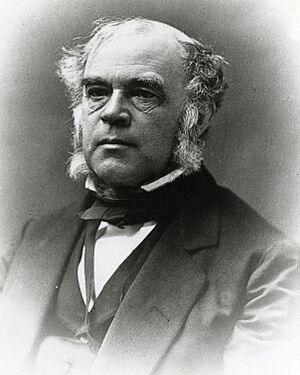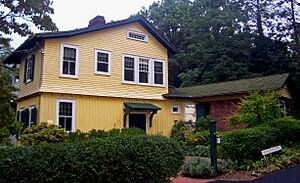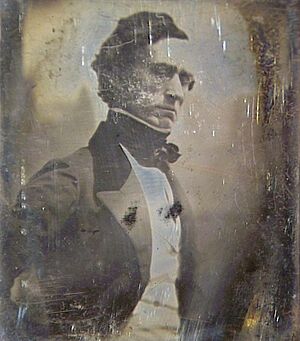John William Draper facts for kids
Quick facts for kids
John William Draper
|
|
|---|---|

John William Draper, c. 1879
|
|
| Born | May 5, 1811 St. Helens, Lancashire, England, United Kingdom
|
| Died | January 4, 1882 (aged 70) Hastings-on-Hudson, New York, United States
|
| Nationality | British |
| Alma mater | University College London University of Pennsylvania |
| Known for | Photochemistry Draper point Grotthuss–Draper law |
| Awards | Rumford Medal (1875) |
John William Draper (born May 5, 1811 – died January 4, 1882) was a brilliant scientist from England. He was also a doctor, chemist, historian, and photographer. He is famous for being one of the first people to take portrait photos. He also took the very first detailed photograph of the Moon in 1840!
Draper helped start the New York University School of Medicine. He was also the first leader of the American Chemical Society. One of his most famous books was History of the Conflict between Religion and Science. This book explored the historical relationship between science and religion. It became very popular and was translated into many languages.
Draper's family included many scientists. His son, Henry Draper, and granddaughter, Antonia Maury, were astronomers. Another granddaughter, Carlotta Maury, was a paleontologist. His eldest son, John Christopher Draper, was a chemist, and his son Daniel Draper was a meteorologist.
Contents
Early Life and Education
John William Draper was born on May 5, 1811, in St. Helens, England. His father, John Christopher Draper, was a clergyman. John William had three sisters: Dorothy Catherine Draper, Elizabeth, and Sarah.
Because his father moved often for work, John William was mostly taught at home. In 1822, he went to Woodhouse Grove School. Later, in 1829, he studied chemistry at University College London.
In 1831, John William Draper married Antonia Caetana de Paiva Pereira Gardner. She was the daughter of a doctor to the King of Portugal. Antonia was born in Brazil.
After his father passed away in 1831, John William's family moved to the United States. They hoped he could find a teaching job there.
Life in America
In 1832, the Draper family settled in Mecklenburg County, Virginia. John William set up a laboratory there. He did many experiments and wrote several scientific papers. His sister, Dorothy Catherine, helped pay for his medical studies by teaching art.
In March 1836, he earned his medical degree from the University of Pennsylvania School of Medicine. That same year, he started teaching at Hampden–Sydney College in Virginia.
Moving to New York City
In 1837, Draper was offered a job as the head of chemistry at a new medical school in New York University. However, the school didn't have enough money to start right away.
In 1839, Draper became a professor of chemistry and botany at New York University. He moved his family to New York City. He then helped create the New York University Medical School. He was a professor there from 1840 to 1850. He also served as the school's president from 1850 to 1873. He continued teaching chemistry until 1881.
Amazing Scientific Discoveries
John William Draper made many important scientific contributions. He did a lot of research in photochemistry, which is about how light causes chemical changes. He also greatly improved Louis Daguerre's process for making photographs. This made portrait photography possible for the first time.
He wrote several textbooks, including books on chemistry, natural philosophy, and physiology. He also published his scientific research on radiant energy.
Pioneering Photography
In 1839, Draper experimented with early photography methods in Virginia. He wasn't happy with the results. When he learned about the new daguerreotype process, he decided to try it.
In September 1839, Draper, now a professor in New York, started taking landscape photos. Around September 23, he took one of the very first daguerreotype portraits. It was a picture of his assistant, William Henry Goode.
Draper spent much of 1839 and 1840 trying to perfect portrait photography. He worked with Samuel Morse, who invented the telegraph. In spring 1840, they even opened one of the first photography studios in New York City.
Draper also famously photographed his sister, Dorothy Catherine Draper. One of these pictures became well-known when he sent it to another scientist, John Herschel, in 1840.
In March 1840, Draper became the second person ever to photograph a celestial object. He took the first detailed photographs of the Moon. In 1843, he took daguerreotypes of the solar spectrum. These pictures showed new light lines that couldn't be seen with the naked eye. By 1850, he was making photomicrographs, which are photos taken through a microscope. His 13-year-old son, Henry, even helped him with this work.
Important Scientific Laws
In 1842, Draper proposed an important idea: only light rays that are absorbed can cause chemical changes. This idea later became known as the Photoelectrochemical processes#Grotthuss–Draper law. It was named after him and another scientist, Theodor Grotthuss, who had a similar idea earlier.
In 1847, he observed that all solid objects glow red at about the same temperature. This temperature, around 977°F (525°C), is now called the Draper point.
Contributions to History
Draper is also well-known for his books on history. His book, The History of the Intellectual Development of Europe (1862), looked at history using scientific methods. He also wrote a three-volume History of the American Civil War (1867–1870).
His most famous history book was History of the Conflict between Religion and Science (1874). This book explored the relationship between science and religion throughout history. Draper argued that the growth of human knowledge often faced challenges from traditional beliefs. This book was very popular, selling many copies in the United States and being translated into ten languages.
Draper was recognized for his work by being elected to the American Philosophical Society in 1844. He also served as the first president of the American Chemical Society in 1876. In 1877, he was elected to the National Academy of Sciences.
Draper's Children
John William Draper and Antonia had several children who also achieved great things:
- John Christopher Draper (1835–1885)
- Henry Draper (1837–1882)
- Virginia Draper Maury (1839–1885)
- Daniel Draper (1841–1931)
- William Draper (1845–1853)
- Antonia Draper Dixon (1849–1923)
Later Life and Legacy

John William Draper passed away on January 4, 1882, at his home in Hastings-on-Hudson, New York. He was 70 years old. He was buried in Green-Wood Cemetery in Brooklyn, New York.
Draper's home, known as the Henry Draper Observatory, was named a National Historic Landmark in 1975. This means it's a very important historical place.
In 1976, New York University started a special master's program in his honor. It's called the John W. Draper Interdisciplinary Master's Program. This program celebrates his belief in studying different subjects together.
In 2001, Draper and the founding of the American Chemical Society were recognized as a National Historic Chemical Landmark at New York University. This highlights his important role in chemistry history.
Images for kids
-
The Draper House (Henry Draper Observatory).









